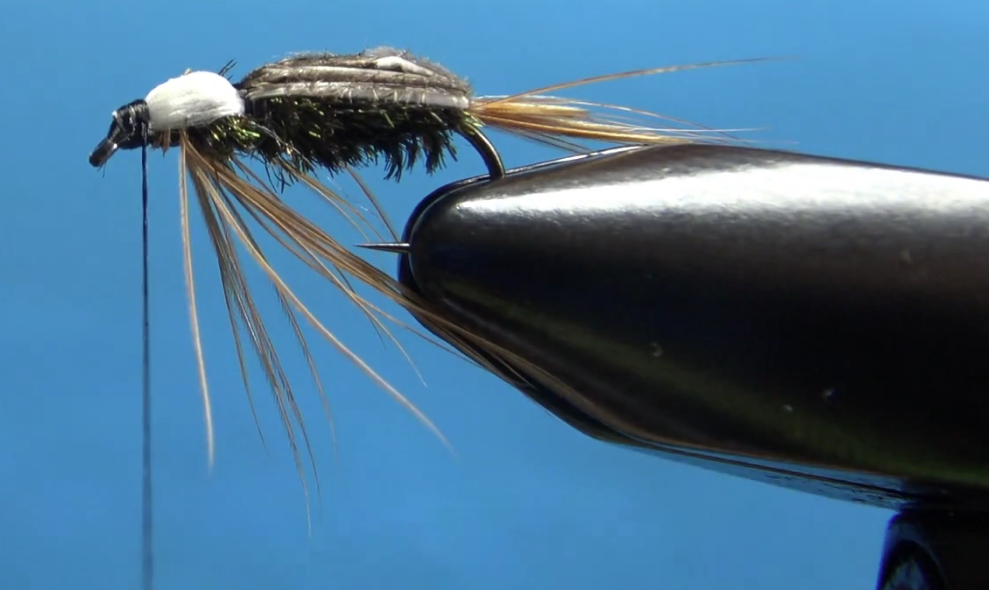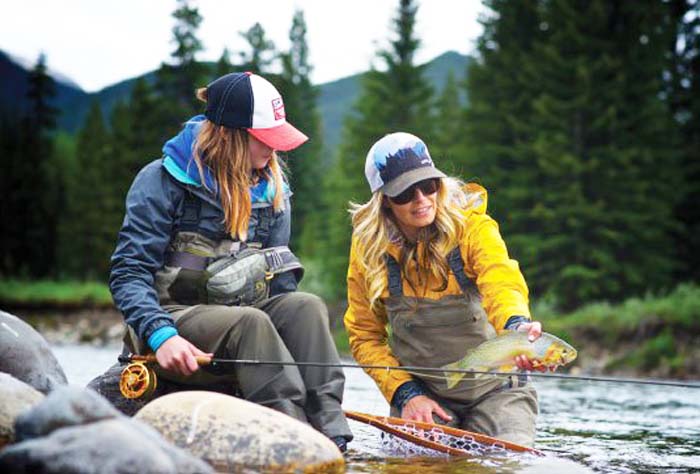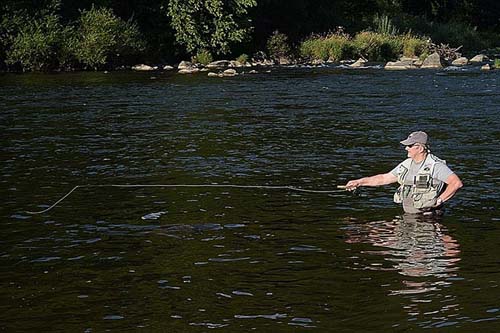
Photo of Wladyslaw Trzebunia with a nice grayling taken by Richard R. Twarog.
A nymphing technique and a nymph that plays well in away games:

Skip Clement, New Zealand.
By Skip Clement
I have never been a good nymphing angler, at least not when compared to Angie Roth, my often angling partner, who has made that technique a lifetime achievement of her fly fishing. So naturally, Tenkara, which I choose to label a noun, was as easy for her as if an inheritance.
Her proficiency in that fly fishing is as graceful as hoped for by modern Tenkara followers witnessed in riverine angling situations from Idaho to the Adirondacks and here in the Georgia Mountains.
NOTE: Trying to cast a nymphing setup is awkward at best – it is so much more efficient and artful to see Angie lob her nymph presentation when Polish Nymphing, and especially so when Tenkara fly fishing.
Angie Roth’s nymphing is so traditional that her link to the technique is in the past so far that today’s boys and girls with ‘Hamburger Helper’ nymphing techniques would call the police for being overworked by their super ‘traditionalist’ guide. At its origin, Wladyslaw Trzebunia nymphing technique was louder in competitive fly fishing than a season football score in the New York Times headlined, Wellesley College’s new football team routes Notre Dame 37 to 13 in Yankee Stadium.
What a sight it was
The year was 1989. The place was Kuusamo, Finland. The event was the World Fly Fishing Championship. A gaggle of journalists and bystanders followed and watched in wonder and curiosity: Who was this guy dressed in an unconventional vest, wearing garden boots for waders, and casting a mended fly rod? He was tenacious and very competitive, with a broad, quick smile — friendly. The mystery angler was Wladyslaw Trzebunia, then a Polish national Fly Fishing Team member. “Vladi,” as he is known to his friends, is the man who knocked the fly-fishing world on its butt.
In the mid-1930s, Vladi’s father discovered that he caught more fish when he pulled his baited hook downstream faster than the current.
Here’s the takeaway: The fish were attracted to the motion
Back to the 1989 tournament: Using the same basic method his father had taught him as a youngster (with refinements, to be sure), Vladi landed a staggering total of 60 fish. That number was more than all of the 2nd, 3rd, and 4th teams combined! Wladyslaw Trzebunia won the individual title–and a dazzling gold medal—and the Polish team took the team title.
Since that 1989 competition, the nymphing that method Vladi pioneered, and the Polish team used, has been imitated, appropriated, and re-named throughout Europe and the rest of the fly fishing world. Over time, Vladi’s method has been reborn to new fathers of new nationalities.
Photo of holding his fly rod parallel to the water’s surface, Vladi pulls the flies through the current. NOTE: A 9-foot, 4- or 5-weight rod is a minimum, an R.B. Meiser 909 switch rod [9′ 9″] 2-weight rod [equivalent to any 5-weight] is perfect and functions conventionally cast, and any 10-foot Meiser spey rod also perfect for nymphing. Photo by Richard R. Twarog.
Here are some important points about Polish nymphing:
-
The Polish method works best in fast water, perhaps no deeper than the middle of your thighs, about three feet. For example, the tail-outs of pools or just downstream from riffles are great feeding locations for this method, even if the water is a little off-color.
-
Typically, your leader should be a little more than 2/3 the length of the rod. So, for a 9-foot rod, a 7-foot leader would be about right. I use an 8-foot tippet as a leader on my 10-foot rod. If you want to change from using a floating line to fishing dry flies, just keep the same line and change your tapered leader to a straight tippet that will sink much faster, and you’re all set. Remember, you’re not casting the nymph(s); you just lob them upstream.
-
This is an active, not passive, way to enjoy fishing. You’re triggering a strike, not standing there waiting and watching a bobber float by. You can use either a single-weighted fly or a multi-fly rig. With a multi-fly rig, one of the flies (the anchor fly) must be heavy enough to bring the flies to the river’s bottom quickly. Remember, the flies are not in tandem.
-
After you lob the fly upstream and feel it touch the bottom, I start pulling the fly downstream a little faster than the current. That’s the key: pulling faster than the current.
-

Eddy George of Louisville, Tennessee 1955 Cotton Top.
I usually hold my rod parallel to the water as I pull the fly downstream. Then I raise it a little when the fly is even with me and let it drift past a few feet and rise toward the surface. Just before I start to pick up my line to lob it upstream again, I set the hook to an imaginary fish. I’ve been amazed how many hook-ups I get because trout and grayling are likely to follow a food item that is quickly moving around in the current and will often eat it as it rises. If I don’t get a strike in two or three upstream lobs, I sidestep downstream about three or four feet.
-
The unique combination of the fish’s lateral line and vision is designed specifically to detect the motion of predator or prey, which is why Vladi’s method seems like the obvious way to nymph.
That’s what Vladi has taught me over the past six years. And not only is it productive, but it’s a lot of fun, too.
— Written by: Richard R. Twarog, author of The San Juan River: A Fly Angler’s Journal.
NOTE: Vladi, as of 2018, was a licensed guide in Poland and Slovakia and continues to give seminars and teach international competitive teams and individuals.
The George Nymph
This nymph is a quick sink, and when swum aggressively, Angie said, ‘It is as good if not better than the more traditional nymphs like the Pheasant Tail, Hare’s Ear, Prince Nymph, Copper John and a few others.‘ Adding, ‘The George Nymph, as tied by Matt O’Neal [Savage Flies], would encourage an eat anywhere there are trouts or crappie.’
The fly was created by Eddy George of Louisville, Tennessee, in 1955. The ‘Cotton Top’ nymph is a good searching nymph or stonefly imitation. Savage says, ‘The nymph has been a staple of Great Smoky Mountain fly fishers and is equally as effective in many trout fisheries. Fish this weighted for a fast-sinking fly that gets deep quickly.’
- Hook: #12-18 standard or 1x long nymph
- Thread: Black Weight: 0.015 or 0.020
- Tail: Brown hackle fibers
- Body: Peacock herl
- Wingcase lower: Mottled turkey feather
- Wing-case thorax: White yarn or Antron/Z-lon
- Throat: Brown hen hackle



